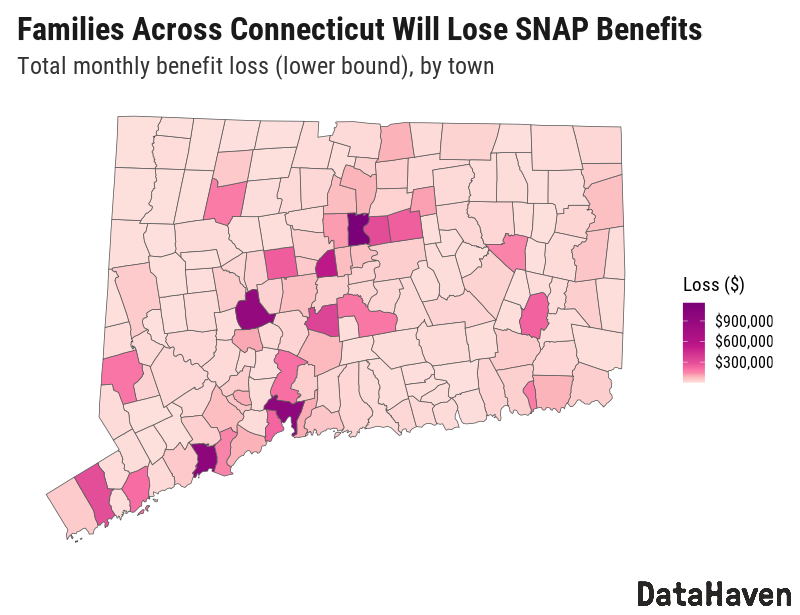All DataHaven Programs, Economy, Health
New DataHaven Estimates Show SNAP Cuts Threaten Food Security and Local Economies Statewide
Today, DataHaven released a new report titled “Food Assistance and Local Economies at Risk: Projected Federal SNAP Cuts by Connecticut Town and District,” analyzing projected losses of Supplemental Nutrition Assistance Program (SNAP) benefits tied to recent federal policy changes. According to a July 2025 report from the Urban Institute, 58,000 families in Connecticut are expected to lose at least $25 per month in SNAP benefits, with these families experiencing an average monthly benefit loss of $194. Overall SNAP benefits losses throughout the state will total between $11M and $15M each month.
The new DataHaven report provides town- and legislative district-level estimates across Connecticut. For example, in Hartford, about 6,000 families are expected to lose $25 or more in monthly SNAP benefits, with benefit losses totaling between $1.1M and $1.6M each month. Bridgeport, New Haven, and Waterbury are each projected to see over 4,600 families losing $25 or more in monthly benefits, adding up to total benefit losses of between $890,000 and $1.3 million per month in each city. Impacts will reach beyond urban areas, too. In the state’s northeast corner, 1,700 families from State Senate District 29 stand to lose at least $25 per month, with benefit losses in that area totaling $330,000 to 440,000 per month.
These projected losses stem from federal legislation (the “One Big Beautiful Bill Act”), which introduces work requirements, administrative hurdles, and additional cost burden for states. Under the new law, even as Connecticut pays more to sustain its SNAP program, residents are likely to see essential nutritional benefits diminish or disappear entirely.
The report includes links to interactive data visualizations and colorful maps, showing impacts at the town and legislative district level. Visit the DataHaven website, at ctdatahaven.org/snapcuts, to read the full report.
Researchers and policy experts from DataHaven, The Connecticut Project Action Fund, End Hunger CT, and other statewide organizations are available to comment on the report.
“People in every corner of our state are being crushed by the cost of living, and as this data shows, federal SNAP changes are only going to make that worse,” said Meghan Holden, Director of Marketing and Communications for The Connecticut Project Action Fund. “Right now, 58,000 Connecticut households are at risk of losing an average of $194 per month in SNAP benefits. That money is the difference between a child going to bed with an empty belly or full, between a veteran eating one meal a day or three, between hunger and survival. Our state has to call a special session and broaden and fund the federal safeguard account to protect working class people from SNAP cuts, now.”
“Feeding hungry people should not be a political problem. Food is the most basic building block for a healthy, thriving community. When we cut SNAP, we’re not just cutting benefits — we’re cutting stability, long-term health, and opportunity. Food is medicine. Food is educational success. Food is jobs. Every dollar invested in SNAP pays dividends in healthcare, education, and economic resilience,” said Meg Hadley Zimmerman, Program Manager at End Hunger CT!.
“These cuts to SNAP benefits are coming at a time when rates of food insecurity in Connecticut have reached historic highs, putting even more pressure on families and local main streets alike. This new report is important because it provides town- and district-level estimates that can help legislators and advocates understand the on-the-ground impacts of recent legislation,” said Mark Abraham, Executive Director at DataHaven. “In addition to putting food on the table and ensuring that all children have the nutrition they need to succeed, SNAP benefits keep dollars flowing through neighborhood businesses and help support local jobs. These data make it clear how cutbacks in SNAP as a result of work requirements and other federal policy changes are going to have a significant impact on communities across the entire state.”

